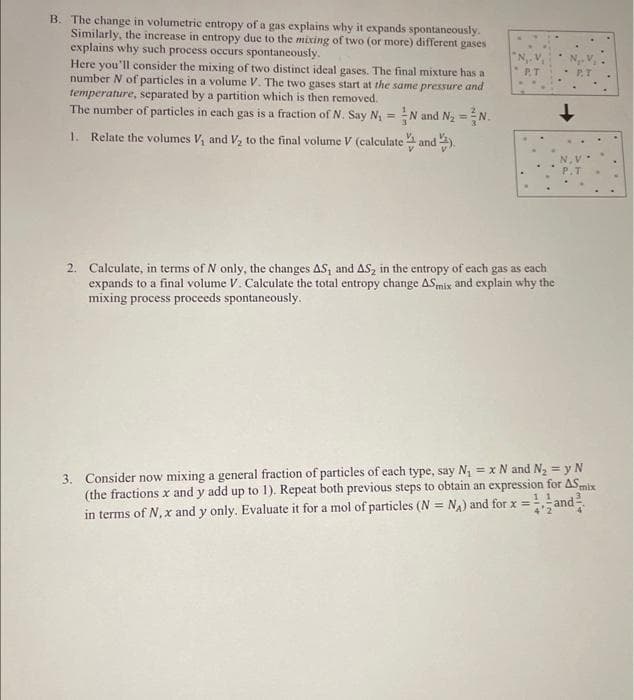B. The change in volumetric entropy of a gas explains why it expands spontaneously. Similarly, the increase in entropy due to the mixing of two (or more) different gases explains why such process occurs spontaneously. Here you'll consider the mixing of two distinct ideal gases. The final mixture has a number N of particles in a volume V. The two gases start at the same pressure and temperature, separated by a partition which is then removed. The number of particles in each gas is a fraction of N. Say N₁ = N and N₂ = N. and ). 1. Relate the volumes V₁ and V₂ to the final volume V (calculate P.T 2. Calculate, in terms of N only, the changes AS, and AS, in the entropy of each gas as each expands to a final volume V. Calculate the total entropy change ASmix and explain why the mixing process proceeds spontaneously.
B. The change in volumetric entropy of a gas explains why it expands spontaneously. Similarly, the increase in entropy due to the mixing of two (or more) different gases explains why such process occurs spontaneously. Here you'll consider the mixing of two distinct ideal gases. The final mixture has a number N of particles in a volume V. The two gases start at the same pressure and temperature, separated by a partition which is then removed. The number of particles in each gas is a fraction of N. Say N₁ = N and N₂ = N. and ). 1. Relate the volumes V₁ and V₂ to the final volume V (calculate P.T 2. Calculate, in terms of N only, the changes AS, and AS, in the entropy of each gas as each expands to a final volume V. Calculate the total entropy change ASmix and explain why the mixing process proceeds spontaneously.
Introduction to Chemical Engineering Thermodynamics
8th Edition
ISBN:9781259696527
Author:J.M. Smith Termodinamica en ingenieria quimica, Hendrick C Van Ness, Michael Abbott, Mark Swihart
Publisher:J.M. Smith Termodinamica en ingenieria quimica, Hendrick C Van Ness, Michael Abbott, Mark Swihart
Chapter1: Introduction
Section: Chapter Questions
Problem 1.1P
Related questions
Question

Transcribed Image Text:B. The change in volumetric entropy of a gas explains why it expands spontaneously.
Similarly, the increase in entropy due to the mixing of two (or more) different gases
explains why such process occurs spontaneously.
Here you'll consider the mixing of two distinct ideal gases. The final mixture has a
number N of particles in a volume V. The two gases start at the same pressure and
temperature, separated by a partition which is then removed.
The number of particles in each gas is a fraction of N. Say N₁ = N and N₂=N.
1. Relate the volumes V₁ and V₂ to the final volume V (calculate and ).
P.T
2. Calculate, in terms of N only, the changes AS, and AS, in the entropy of each gas as each
expands to a final volume V. Calculate the total entropy change ASmix and explain why the
mixing process proceeds spontaneously.
P.T
3. Consider now mixing a general fraction of particles of each type, say N₁ = x N and N₂ = y N
(the fractions x and y add up to 1). Repeat both previous steps to obtain an expression for ASmix
in terms of N, x and y only. Evaluate it for a mol of particles (N = N₁) and for x = and
4 2
Expert Solution
This question has been solved!
Explore an expertly crafted, step-by-step solution for a thorough understanding of key concepts.
Step by step
Solved in 5 steps with 5 images

Recommended textbooks for you

Introduction to Chemical Engineering Thermodynami…
Chemical Engineering
ISBN:
9781259696527
Author:
J.M. Smith Termodinamica en ingenieria quimica, Hendrick C Van Ness, Michael Abbott, Mark Swihart
Publisher:
McGraw-Hill Education

Elementary Principles of Chemical Processes, Bind…
Chemical Engineering
ISBN:
9781118431221
Author:
Richard M. Felder, Ronald W. Rousseau, Lisa G. Bullard
Publisher:
WILEY

Elements of Chemical Reaction Engineering (5th Ed…
Chemical Engineering
ISBN:
9780133887518
Author:
H. Scott Fogler
Publisher:
Prentice Hall

Introduction to Chemical Engineering Thermodynami…
Chemical Engineering
ISBN:
9781259696527
Author:
J.M. Smith Termodinamica en ingenieria quimica, Hendrick C Van Ness, Michael Abbott, Mark Swihart
Publisher:
McGraw-Hill Education

Elementary Principles of Chemical Processes, Bind…
Chemical Engineering
ISBN:
9781118431221
Author:
Richard M. Felder, Ronald W. Rousseau, Lisa G. Bullard
Publisher:
WILEY

Elements of Chemical Reaction Engineering (5th Ed…
Chemical Engineering
ISBN:
9780133887518
Author:
H. Scott Fogler
Publisher:
Prentice Hall


Industrial Plastics: Theory and Applications
Chemical Engineering
ISBN:
9781285061238
Author:
Lokensgard, Erik
Publisher:
Delmar Cengage Learning

Unit Operations of Chemical Engineering
Chemical Engineering
ISBN:
9780072848236
Author:
Warren McCabe, Julian C. Smith, Peter Harriott
Publisher:
McGraw-Hill Companies, The